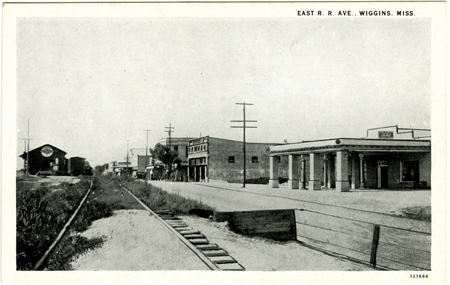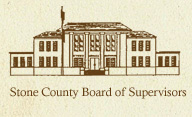 The county seat of Stone County is known to most everyone as Wiggins – but it hasn’t always been known by that name. Early in 1830, the area’s first settlers came to a beautiful country, which was completely covered with virgin timber. In 1886, James Madison Hatten, son of Wiggins Hatten, homesteaded 160 acres of north central Harrison County. Due to the need for having a definite place to meet, trade and exchange news, a small village was established on a portion of Mr. Hatten’s land. The village was named Niles City, in honor of Judge H. C. Niles. In 1896, an attempt was made to get a post office in that name, but since there was a Niles City, Michigan, the Post Office Department declined. Therefore, another name had to be selected.
The county seat of Stone County is known to most everyone as Wiggins – but it hasn’t always been known by that name. Early in 1830, the area’s first settlers came to a beautiful country, which was completely covered with virgin timber. In 1886, James Madison Hatten, son of Wiggins Hatten, homesteaded 160 acres of north central Harrison County. Due to the need for having a definite place to meet, trade and exchange news, a small village was established on a portion of Mr. Hatten’s land. The village was named Niles City, in honor of Judge H. C. Niles. In 1896, an attempt was made to get a post office in that name, but since there was a Niles City, Michigan, the Post Office Department declined. Therefore, another name had to be selected.
To honor Wiggins Hatten, one of the area’s pioneers, the name Wiggins was chosen. At the close of the Civil War, Niles City (Wiggins) remained a part of Harrison County with the county seat being at Mississippi City. Reconstruction days in Harrison County were difficult as they were all across the South. At the close of the war, there was little money in circulation and the citizens had to depend on what they produced, part of which was carried to market to be traded for coffee, sugar and flour. Clothes were homespun and there were no cash transactions. However, these economic conditions began to improve, and during late 1800s, a dream came true for the people of Wiggins when a railroad was built through the center of the county.
Captain J. T. Jones of Buffalo, NY, built the road from Hattiesburg to Gulfport, being called the Gulf and Ship Island Railroad. The road was graded through to somewhere about present day Saucier and the track was laid some miles to a point about Lyman. The railroad was completed to Bond sometime in the year of 1893.
 During this time, south Mississippi was covered with virgin Yellow Pine, and timber was a major concern. The first sawmill to be established in this section of Harrison County was built by J. F. P. Bond and Columbus Ireland. The mill opened early March of 1896. This mill cut the material with which the railroad was built. Following the construction of the railroad, J. F. P. Bond, Columbus Ireland, E. J. Bond, and Preston bond constructed a larger sawmill on the same site. They later sold the mill to Blackshear and Swanson of Brewton, AL. During the same year, John McMullin built a mill across the railroad and operated it for about a year. Both mills were later sold to John H. Gary, who in the year 1902, sold them to Finkbine Lumber Company, a company made up of a group of Iowa businessmen.
During this time, south Mississippi was covered with virgin Yellow Pine, and timber was a major concern. The first sawmill to be established in this section of Harrison County was built by J. F. P. Bond and Columbus Ireland. The mill opened early March of 1896. This mill cut the material with which the railroad was built. Following the construction of the railroad, J. F. P. Bond, Columbus Ireland, E. J. Bond, and Preston bond constructed a larger sawmill on the same site. They later sold the mill to Blackshear and Swanson of Brewton, AL. During the same year, John McMullin built a mill across the railroad and operated it for about a year. Both mills were later sold to John H. Gary, who in the year 1902, sold them to Finkbine Lumber Company, a company made up of a group of Iowa businessmen.
This mill was operated while the new mill was being constructed, about one mile east of the railroad, in the area of present day Stapp Street.
Wiggins was incorporated in March 0f 1904, by a petition signed by two-thirds of the qualified electors residing within the proposed territory. As in accordance with the law of the state, a proclamation was signed on March 26, 1904 incorporating the municipality of Wiggins in Harrison County.
The first town meeting was held on April 25, 1904 at 7:30 p.m. at the office of E. R. Davis, Justice of the Peace. The meeting was held for the purpose of organizing. It was attended by W. R. Barber, Mayor; J. A. Simpson, Marshall; C. B. O’Neal, Treasurer; W. H. Rowan, E. I. Bailey, J. M. Price, J. Klumb and W. F. Bond, Aldermen. At this meeting the Governor’s proclamation and Town Charter were adopted and spread upon the minutes.
The building for the town jail was proposed at the first regular meeting of the Town Council, May 3, 1904, and a short time afterwards it was built. The jail was 12’x20’, it was 10’ high and had two rooms. It was to be “well spiked, and substantially constructed.” Several years later, as a Halloween prank, enterprising young boys overturned the “substantially constructed” jail. Later it was decided to construct a new town jail.
 The first Town Hall, used as Mayor’s and Marshall’s office, was the rear room of the second floor of the City Drug Store Building, which was rented from E. R. Davis, June 28, 1904. The meeting place was changed May 2, 1905 to a room in the rear of the Citizen’s Bank Building, on the first floor, formerly occupied by T. J. Walton, Dentist. A lot for Town Hall was purchased later for the sum of $100.
The first Town Hall, used as Mayor’s and Marshall’s office, was the rear room of the second floor of the City Drug Store Building, which was rented from E. R. Davis, June 28, 1904. The meeting place was changed May 2, 1905 to a room in the rear of the Citizen’s Bank Building, on the first floor, formerly occupied by T. J. Walton, Dentist. A lot for Town Hall was purchased later for the sum of $100.
On January 21, 1910, a fire destroyed all the business part and a few residences on the east side of the railroad. The meeting place for the Town Council was then moved to a room located in the southwest corner of the school building and on February 7, 1910, the fire limits of the town were fixed. The town of Wiggins gradually rebuilt with “Modern” brick buildings.
The first town census, taken in 1910, showed Wiggins was thriving with 980 residents.
Knowing the supply of timber was rapidly becoming exhausted, Mr. W. E. Guild, Treasurer and General Manager of the Finkbine Lumber Company, decided a pickle and canning plant would provide the farmers a market for products grown on the cut-over lands. From the ashes of the once vast tracts of virgin pine forests rose an enterprise that spanned generations, in 1912 the American Pickle and Canning Company was founded with Finkbine Lumber interests.
The first plant burned in 1913 and was replaced immediately with new buildings. The enterprise grew and during World War I, with the great demand for foodstuffs, business was good. In 1918, with J. J. McClure, manager and Roy Tate, foreman, pickles and canned sweet potatoes were shipped in carload lots to all over the country. In 1919, L. L. Coleman was made assistant manager, and beans and blackberries were also canned.
In 1920, a branch factory was built in Hattiesburg, with a larger capacity than the one in Wiggins. In 1923, the Wiggins factory began to produce pickles and its condiments exclusively and the main office was moved back to Wiggins. It was located in the Finkbine Office at the mill. The company boasted a profit of $300,000 and employed 150 persons with a payroll of $1,100. Within two years, they had 20 salting stations and had built a $10,000 warehouse.
In 1924, an article printed in the Stone County Enterprise, stated that the outlook for Wiggins was very promising. “Wiggins is on a boom and her citizens are showing their prosperity and progressiveness in various new enterprises and ways.”
 In 1924, Wiggins boasted four churches, Baptist, Methodist, Presbyterian and Catholic, and had just voted to float a $100,000 bond issue to build a highway through Wiggins from the Pearl River County line to the George County line, thereby opening a direct highway through the county from new Orleans to Mobile.
In 1924, Wiggins boasted four churches, Baptist, Methodist, Presbyterian and Catholic, and had just voted to float a $100,000 bond issue to build a highway through Wiggins from the Pearl River County line to the George County line, thereby opening a direct highway through the county from new Orleans to Mobile.
In 1926, the Widlar Company of Cleveland, Ohio purchased the pickle factory and all salting stations. They enlarged the plant, held open house one day a week for visitors and improved equipment and gave birth to the American Pickling Company. In 1929, the Standards Brands, Inc., operated the plant Widlar Division, which absorbed the Widlar Company.
In the June 19, 1930 edition of the Stone County Enterprise, the following was reported, “... cucumber by the thousands of pounds are arriving daily and forces of men and women are kept at work late into the night and on Sunday to get the fresh products into the brine. Large trucks from the five stations that use the plant as their salting station, come into the plant here, each evening, their capacity is around 8,000 pounds each. This plant is at the present time paying out to the farmers over this territory from $500 to $1,000 daily for cucumbers. They have received approximately to date 135,000 bushels of cukes. They are also bottling olives and expect to being operating within the next sixty days, their salad dressing department, the equipment for same has already been installed. This department will average a carload of finished products per day.”
Through the years, the pickle plant continued to prosper and grow, changing owners until in 1961, Stone County voters went to the polls and voted their approval of a $450,000 BAWI bond issue to finance expansion of the pickle plant, then owned by Brown-Miller Company. The vote was 1,989 for and 22 opposed. The new expansion had 73,000 sq ft of floor space and was built of steel, brick and masonry. It connected to the existing plant on the east side and housed the “newest and most modern” equipment for increased production. While the pickle plant coasted through four wars and a depression, the 1980s began to take its toll, and Rainbow Foods, Inc., owner of the pickle plant, began to cut employees. And despite the assurances of Richard Hewling, general manager, in an interview with the Stone County Enterprise, that “Wiggins is very centrally located to the heart of our customer market area, and as a distribution center, will remain a very important part of our operations...” the pickle plant slowly shut its doors putting an end to an era of Wiggins’ history.
Today, Wiggins is one of the fastest growing communities in Mississippi. Residents enjoy a high quality of life and are less than an hour from Hattiesburg and the Mississippi Gulf Coast.
Information contributed by the Stone County Enterprise.



